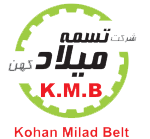Textile flat belt
Flat textile belts are a type of power transmission belts.
Belts that are used in industrial tools, either transfer and transport materials on them, which are called conveyor belts, or transfer engine power or torque to other parts and rotate rollers. They are called power transmission belts.
The power transmission belt, unlike the conveyor belt, does not have large dimensions and is not very wide.
Instead, it has very high strength and tensile strength due to its special material. Flat belt is one of the types of power transmission belt.
Types of flat belts
One form of this belt is its leather type. This type can be two or more layers and in its middle layers, textiles, weaves and polymers are used.
Flat leather belts are used when there is a high probability of slipping and the speed of the process must be low.
Another type is a textile flat belt made of rubber. In this model, the braids and threads are covered with rubber. This product sticks well to the reel and has a lot of elasticity.
The third type is woven flat belt. which can have from three to twelve layers depending on the thickness. The braids in this model can be made of linen fibers or synthetic fibers. They can be covered with rubber or not.
In addition to transmitting power, like a conveyor belt, a flat belt can also transport objects, like a textile flat belt. The movement of this type of belt is based on overcoming friction and has a very high tensile strength.
Textile flat belt is drier than other types and often cheaper, and one of its features is that it is resistant to pollution and dust.
Textile flat belts are usually composed of several layers, the thickness of which affects its overall strength and resistance. The common material of the belt in the upper and sole parts can be rubber, leather or synthetic fibers.
The three factors that may reduce the amount of friction in the flat textile belt and cause erosion in the movement are moisture, oil and heat.
This type of multi-layer belt is commonly produced and supplied in three ways. Textile flat belt in which polyamide layer is used, which is more useful in cases where more strength is needed.
A belt with a polyester layer in its structure, which increases the speed of the machine’s operation mechanism, and the third is a flat textile belt that has both polyamide and polyester layers in its structure, which has both high strength and increases speed. Gives.
The material of the upper and sole plays a role in the process of corrosion and wear during movement. The thickness of the middle layer or polyamide and the type of fibers of this layer have a great influence on the flexibility of the flat textile belt and its tensile strength.
By increasing the thickness of this middle layer, the flexibility is reduced and the resistance and tensile strength are increased.
German, Japanese, English, and Swiss brands are among the manufacturers of textile belts whose products are offered and sold in Iranian marketing.
This product has medium speed and strength. The fourth and last type is a flat belt with long strings. The long strings are made of linen or synthetic fibers.
This product is in the form of a ring and is very suitable for heavy and high speed processes. The elasticity of this type is low.
This product has a simple structure and needs larger pulleys to move, and its main job is to transmit power in industrial machines.
The pulley that is used to move the flat belt is usually made of cast iron or steel and has two protrusions on the pulley body to fix the position of the belt on itself.
The general features of this type of belt can be mentioned as follows. The textile flat belt should normally be able to withstand the temperature range between 30 degrees and 110 degrees Celsius.
These tools produce little noise while working and do not have much noise pollution. The flat textile belt creates low friction in the machine due to its smooth form without teeth and grooves.
This product is resistant to chemical reaction.

